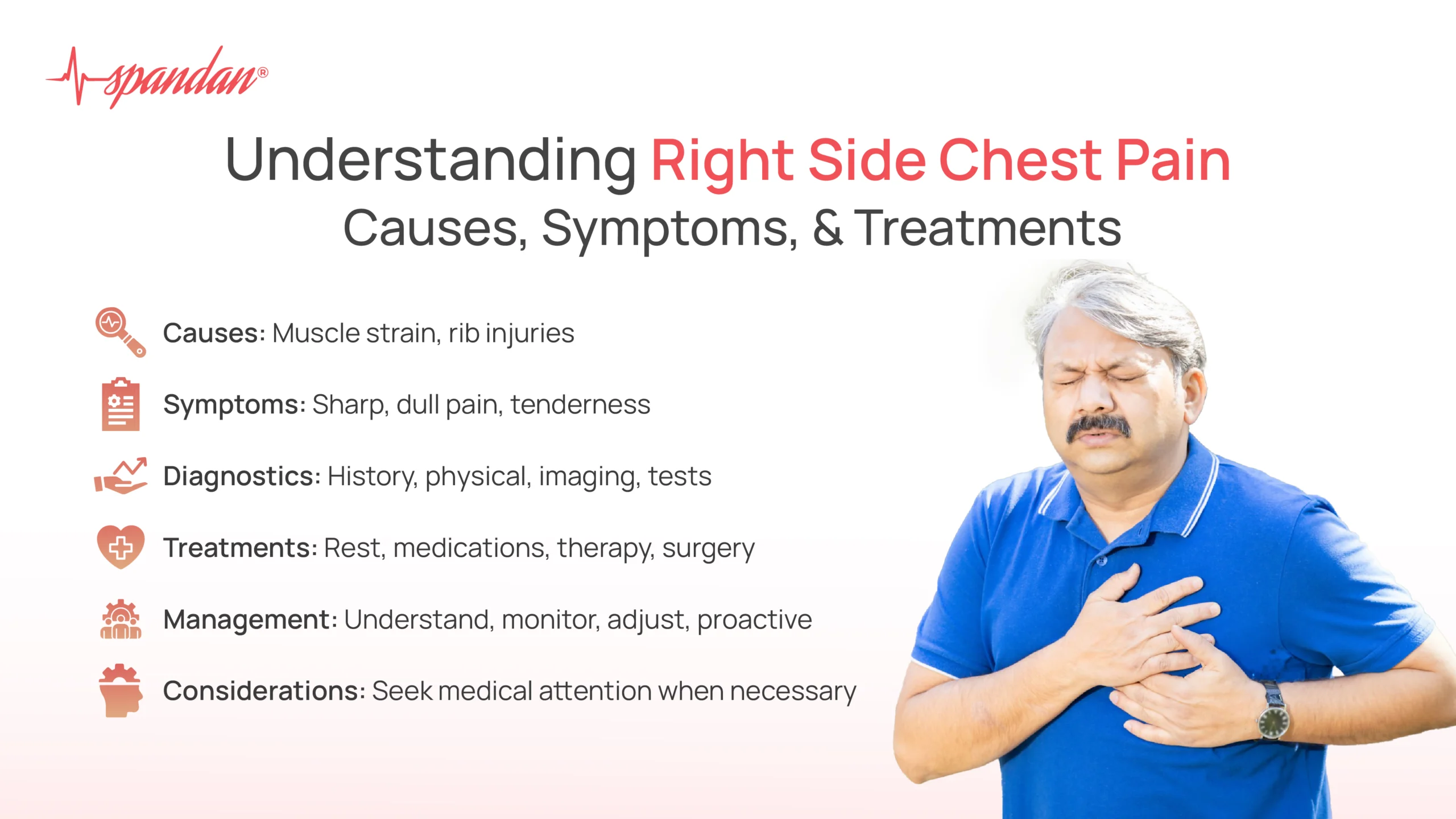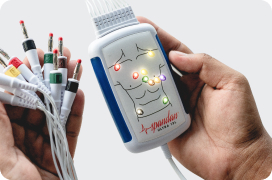
Related Article
Author:- Mr. Ritesh Sharma
Chest pain can be a frightening experience, often evoking concerns about serious health issues like heart attacks and life-threatening cardiac arrhythmias. However, not all chest pain is related to heart problems. Specifically, right side chest pain can arise from various conditions, some of which are benign and others that may require medical attention. Understanding the potential causes, symptoms, and treatments for right side chest pain is crucial for managing your health and knowing when to seek medical help.
Common Causes of Right Side Chest Pain
- Muscle Strain: One of the most common causes of right side chest pain is muscle strain. This can occur from heavy lifting, overexertion, or even prolonged coughing. The pain is usually sharp and exacerbated by movement.
- Rib Injuries: Trauma to the ribs, such as fractures or bruises, can cause significant pain on the right side of the chest. This pain is often localized and worsens with deep breaths or pressure on the affected area.
- Gallbladder Issues: Problems with the gallbladder, such as gallstones or cholecystitis, can cause right side chest pain. This pain often radiates from the upper abdomen to the right chest and can be accompanied by nausea and vomiting.
- Liver Conditions: The liver is located in the upper right part of the abdomen, just below the ribcage. Conditions such as hepatitis or liver abscesses can cause right side chest pain, often felt as a dull ache.
- Lung Conditions: Several lung conditions can lead to right side chest pain. These include pneumonia, pleuritis (inflammation of the lung lining), and pneumothorax (collapsed lung). The pain is usually sharp and may be associated with shortness of breath and coughing.
- Digestive Issues: Acid reflux, peptic ulcers, and gastritis can cause pain that radiates to the chest. This type of pain is often related to eating and may be accompanied by heartburn or indigestion.
- Costochondritis: This is an inflammation of the cartilage that connects the ribs to the sternum. Costochondritis can cause sharp right side chest pain that worsens with movement or deep breathing.
- Anxiety and Panic Attacks: Psychological factors such as anxiety and panic attacks can manifest as right side chest pain. This pain is often accompanied by heart palpitations, sweating, and a sense of impending doom.
Symptoms Associated with Right Side Chest Pain
The symptoms accompanying right side chest pain can vary widely depending on the underlying cause. Here are some common symptoms to watch for:
- Sharp Pain: Pain that is sharp and localized, often related to muscle strain, rib injury, or lung conditions.
- Dull Ache: A persistent, dull ache that could indicate liver conditions or gallbladder issues.
- Radiating Pain: Pain that radiates to other areas, such as the upper abdomen, back, or shoulder, is often associated with gallbladder problems or referred pain from the liver.
- Shortness of Breath: Difficulty breathing can accompany chest pain from lung conditions, such as pneumonia or pneumothorax.
- Nausea and Vomiting: These symptoms often accompany digestive issues like acid reflux or gallbladder disease.
- Heartburn: A burning sensation in the chest, typically related to digestive issues like acid reflux or gastritis.
- Tenderness: Pain that worsens with pressure or movement, commonly seen in cases of costochondritis or rib injuries.
- Anxiety Symptoms: Rapid heartbeat, sweating, dizziness, and a feeling of panic can accompany chest pain related to anxiety or panic attacks.
Diagnosing Right Side Chest Pain
Accurately diagnosing the cause of right side chest pain is essential for effective treatment. Here are some common diagnostic methods:
- Medical History and Physical Examination: Your doctor will take a detailed medical history and perform a physical examination to identify the source of the pain. This may include palpating the chest and abdomen, listening to lung and heart sounds, and assessing for any visible signs of injury or inflammation.
- Imaging Tests: X-rays, CT scans, and MRI scans can help visualize the internal structures of the chest and abdomen, identifying issues such as fractures, lung conditions, or gallbladder problems.
- Blood Tests: Blood tests can detect infections, liver function abnormalities, and markers of inflammation or heart damage.
- Electrocardiogram (ECG): An ECG can help rule out cardiac causes of chest pain by measuring the electrical activity of the heart or if the right side chest pain is indeed due to any cardiac issues, it can manifest as an abnormal ECG in the test.
- Endoscopy: For suspected digestive issues, an endoscopy may be performed to visualize the esophagus, stomach, and duodenum.
- Pulmonary Function Tests: These tests measure lung function and can help diagnose respiratory conditions that may be causing chest pain.
Treatment Options for Right Side Chest Pain
The treatment for right side chest pain depends on the underlying cause. Here are some common treatment approaches:
- Rest and Pain Relief: For muscle strains and minor rib injuries, rest and over-the-counter pain medications such as ibuprofen or acetaminophen can help alleviate pain.
- Medications: Depending on the cause, medications may include antibiotics for infections, anti-inflammatory drugs for conditions like costochondritis, or antacids and proton pump inhibitors for acid reflux.
- Physical Therapy: For muscle-related pain, physical therapy can help strengthen muscles and improve mobility, reducing pain over time.
- Surgery: In some cases, surgical intervention may be necessary, such as for gallbladder removal (cholecystectomy) or repairing a collapsed lung.
- Lifestyle Changes: For digestive issues, lifestyle modifications such as dietary changes, weight management, and avoiding trigger foods can be effective in reducing symptoms.
- Stress Management: Techniques such as deep breathing exercises, meditation, and counseling can help manage anxiety and panic attacks that contribute to chest pain.
- Monitoring and Follow-Up: Regular follow-up with your healthcare provider is important to monitor the condition and adjust treatment as needed.
When to Seek Medical Attention
While right side chest pain can often be attributed to non-life-threatening causes, it’s important to seek medical attention if you experience:
- Severe Pain: Intense or sudden pain that does not improve with rest or over-the-counter medications.
- Shortness of Breath: Difficulty breathing or a feeling of tightness in the chest.
- Radiating Pain: Pain that spreads to the jaw, arm, or back.
- Persistent Symptoms: Pain that lasts for more than a few days without improvement.
- Other Serious Symptoms: Such as dizziness, fainting, or palpitations.
In conclusion, understanding the potential causes and symptoms of right side chest pain is crucial for managing your health and knowing when to seek medical help. While many causes of right side chest pain are benign and can be treated with rest and medication, some conditions require prompt medical attention. If you experience persistent or severe pain, consult with a healthcare professional for an accurate diagnosis and appropriate treatment. By staying informed and proactive about your health, you can effectively manage right side chest pain and maintain a better quality of life.




